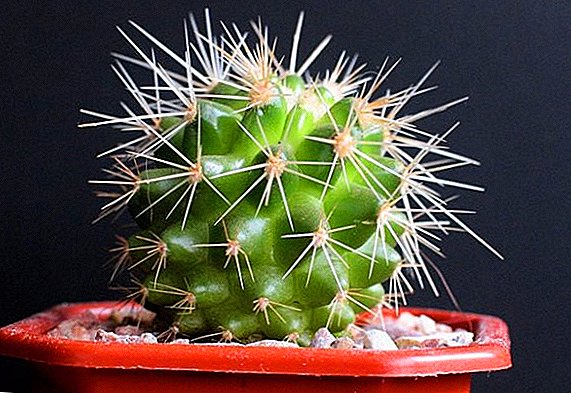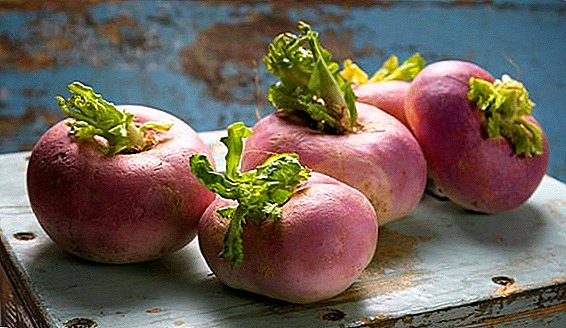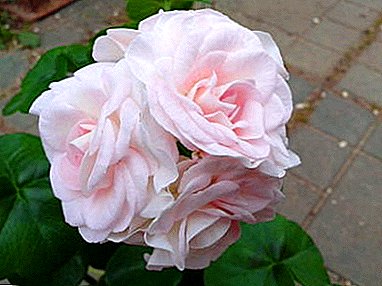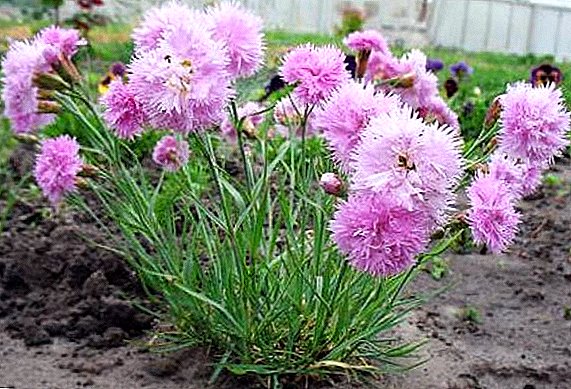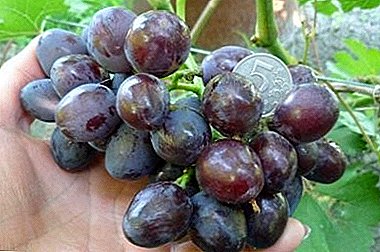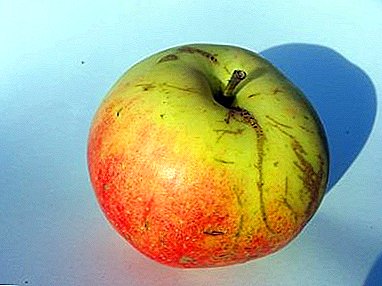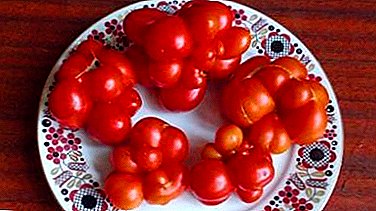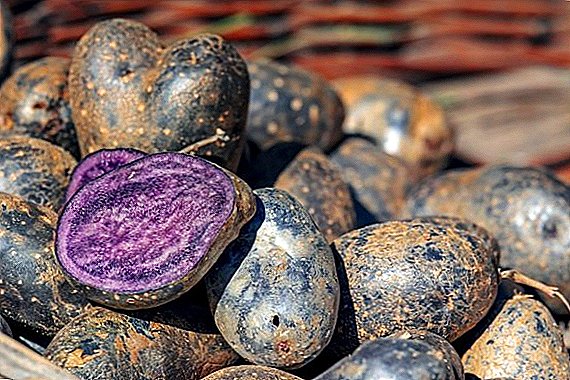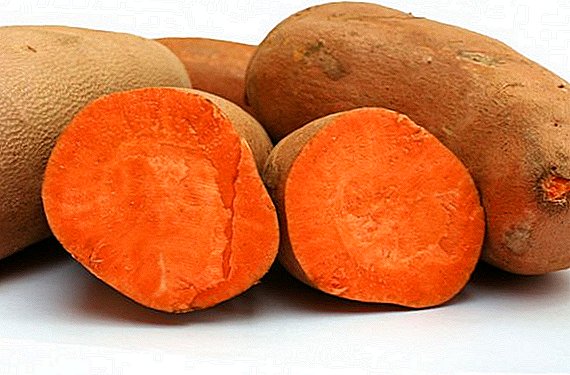 A sweet potato is a tropical plant that tastes vaguely like a sweet potato. Despite its southern origins, it stuck well in the middle lane.
A sweet potato is a tropical plant that tastes vaguely like a sweet potato. Despite its southern origins, it stuck well in the middle lane.
During growth, it spreads along the ground, like a vine, forming thickening on the roots. It is these tubers and can be collected, cook and eat. How to grow such a miracle in my garden and save the harvest, we will talk further.
Sweet Potatoes
Around the world grows a huge number of varieties of sweet potatoes, but not all of them are suitable for cultivation in our climate. Domestic gardeners should pay attention to the early-maturing varieties of plants, in which the growing season is 90-110 days.
 But even under such conditions, you can get a huge variety of crops in color of the pulp, skin and taste. By the way, some varieties have a slightly sweet taste, others distinctly sweet. There are those who simply cannot be distinguished from ordinary potatoes, but there are tubers with a slight nutty flavor.
But even under such conditions, you can get a huge variety of crops in color of the pulp, skin and taste. By the way, some varieties have a slightly sweet taste, others distinctly sweet. There are those who simply cannot be distinguished from ordinary potatoes, but there are tubers with a slight nutty flavor.
Therefore, it is difficult to say exactly what a sweet potato tastes. Let us briefly describe the main varieties growing in the middle lane:
- "Purple" got its name for the dark purple color of the pulp, which persists even after heat treatment. It tastes like ordinary potatoes of the best varieties. It has an average ripening period, it blooms in the middle of summer. It is believed that it contains substances that prolong life.
- "Japanese" It has a light creamy flesh and red skin, it also tastes like potatoes, but more sweet and somewhat dry.
- "Tynung T-65" was launched in Taiwan. This is one of the best early varieties, which forms a fairly large tubers. It has a sweet yellow flesh and pink skin. Resistant to diseases and pests.
- "O.Henry" - dry, sweetish with a yellow flesh and a light cream skin grade. Resistant to diseases. Ripens in 90 days.
- Victory-100 it is widespread in our latitudes, it indulges with excellent harvests even in dry years. It also has a yellowish flesh and a sweetish taste.
- "Ginseng Red" got its name from the white-pink skin, although its flesh is white-yellow. Ribbed tubers give good yields.
- "Manchurian" has a bright yellow sweetish flesh, covered with red skin. Growth patterns and yields are great for small areas.
- "White" is a descendant of classic varieties, has a minimal sweetness, most similar to ordinary potatoes.
- "Garnet" Popular in the United States and we love children for the orange color of the flesh and a great sweet taste. True, the yield is not very high.
- "Jewel" it takes root well in different climatic conditions. Intense orange color wet sweet flesh covered with copper-colored sandpaper.
- "Beoregard" - A classic American variety resistant to diseases and pests. It is characterized by high yields, while the tubers crack a little. This is an early variety with a maturity of up to 110 days. It has a sweet dark orange flesh and a copper-colored skin.
- "Ruby Carolina" got its name for a ruby-red skin and closely-orange flesh. Sweet, wet, rarely sick.
- "Vardaman" similar in taste to ordinary potatoes, although it has a bright orange flesh and a slight sweetness.
- "Covington" different dense sweet orange pulp. Tubers have a flat surface. Well kept.


Growing seedlings at home
The main way of breeding sweet potatoes - sprouts or vines, which are cut from the roots. There is still the possibility of growing from seeds, but not all varieties give them in sufficient quantities. Therefore, seeds are collected mainly for breeding, especially since they germinate very hard.
Important! The sweet potato has a long growing season, during which it must receive a lot of heat. As to provide such conditions in the domestic climate is difficult, planted tubers, he does not have time to start. Therefore, sweet potatoes are grown only through seedlings.The time of tuber planting depends on where you acquired it. If in the store, it is germinated 2-4 months before planting. The tuber purchased from the batatovods is laid in 1-2 months.
To plant a tuber on seedlings in two ways: horizontal or vertical.
 In the first case, the tank with drainage holes is filled with steamed earth, sand is poured on top of 1-2 cm (sometimes with sawdust). Tuber sinks sideways to half, the soil is abundantly watered.
In the first case, the tank with drainage holes is filled with steamed earth, sand is poured on top of 1-2 cm (sometimes with sawdust). Tuber sinks sideways to half, the soil is abundantly watered.
The container is placed in a place with a temperature above 20 ° C and constantly watered. As soon as sprouts appear, the capacity can be taken out to a well-lit place. You can wait for the shoots to reach 10-15 cm, but then they should be gradually taught to the light.
Did you know? If the tuber is rotten, the spoiled part is cut off, and the cut is treated with "green paint".Vertical planting involves the natural location of the tubers, as they grow in the garden. There are several ways of such germination. The choice depends on the sweet potato variety.
If it germinates quickly, dry germination can be used when the tuber is planted as in the horizontal mode, but is set vertically and does not water.
 With the "wet" germination, it is 1/3 vertically immersed in water. In this method, it is permissible to cut the tuber transversely and germinate in halves. They can also be submerged slightly in the water, cut down or treated with activated carbon and gently pressed into the prepared soil.
With the "wet" germination, it is 1/3 vertically immersed in water. In this method, it is permissible to cut the tuber transversely and germinate in halves. They can also be submerged slightly in the water, cut down or treated with activated carbon and gently pressed into the prepared soil.
When sprouts appear, they are waited for when they reach not less than 15 cm in length and are cut so that there are 2-3 internodes in the germ. They are put in the water and waiting for rooting.
Lighting
It is important to know that the plant is very sun-loving. Even a small shadow on it is detrimental. Therefore, it is necessary to grow seedlings and the yam itself only from the south side and in well-lit areas.
Important! The yam will not tie the tubers and grow where it is not warm enough. Therefore, it is important to organize the heating of the place where it grows. For the same reason, a large number of sunny days is not a guarantee of its good growth. The amount of heat produced is important.
Soil and fertilizer
 The ideal soil for sweet potato is silty, sandy, sandy, loamy, in which water lies at a depth of more than two meters. It is necessary to dig up the soil, because the plant loves the friability of the soil, but not deeper than 20 cm, otherwise the roots will be too long and thin, and the roots will not be tied to them.
The ideal soil for sweet potato is silty, sandy, sandy, loamy, in which water lies at a depth of more than two meters. It is necessary to dig up the soil, because the plant loves the friability of the soil, but not deeper than 20 cm, otherwise the roots will be too long and thin, and the roots will not be tied to them.
Fertilize the soil under planting should be in the fall. At this time, it must be dug up with fertilizer at the rate of 3 kg of rotted manure or 5-6 kg of compost, 20 g of superphosphate, 15 g of potassium sulfate per square meter of soil.
Watering and fertilizing soil
The plant is resistant to drought, but in the first months, when there is an intensive growth of yams, it must be watered abundantly. However, over time, the volume of watering should be reduced, and two weeks before harvesting, stop altogether.
During the growing season one or two additional fertilizing with organic fertilizers should take place. In the middle of August, they try to make a top dressing with potassium content, because at this time the harvest is laid. Although he responds well to organic feeding.
Did you know? Watch the foliage of the plant. If it has acquired a purple hue, turned red or yellowed - this is a clear sign that the sweet potato does not have enough potassium.
How to plant seedlings in open ground
 Now let's see when to plant yam in the ground. The answer is simple - when the roots become about 5 cm long. If it is still too cold for open ground, the seedlings can be placed in cups with the soil, but do not keep it there for a long time so that the roots do not intertwine, ruining the next harvest.
Now let's see when to plant yam in the ground. The answer is simple - when the roots become about 5 cm long. If it is still too cold for open ground, the seedlings can be placed in cups with the soil, but do not keep it there for a long time so that the roots do not intertwine, ruining the next harvest.
Pay attention to this when landing in open ground. If the roots are too thick, they can be pruned. It is recommended to plant sprouts almost horizontally in relation to the ground. Then the roots are located close to the surface and have approximately the same size. But in any case, 2-3 knots should be immersed in the ground..
It is possible to plant a plant in an open ground after the last frosts when the soil warms up to 18 ° C. At a temperature of 15 ° C, it may simply not grow, and at 10 ° C, it may even die.
It is advisable to make the beds loose, because the tubers have a high length. At first they should be covered with a film, preferably transparent. So the plant will receive its dose of heat, and weeds without air access will die. Think over the watering system under the film in advance.
Important! If you do not use a film, make sure that the yam does not take root in the internodes, otherwise you will get a low yield. To do this, periodically go through the rows and lift the branches, cutting off the young roots.
Harvesting and storage
 Harvest can be when the foliage begins to turn yellow. As a rule, it is 90-110 days after landing. But it is important that the temperature of the soil does not fall below 11 ° C. While digging, remember that the tubers are now very fragile, and they can be at a considerable distance from the bush.
Harvest can be when the foliage begins to turn yellow. As a rule, it is 90-110 days after landing. But it is important that the temperature of the soil does not fall below 11 ° C. While digging, remember that the tubers are now very fragile, and they can be at a considerable distance from the bush.
After harvesting, immediately select the roots for seedlings, wash them in a solution of potassium permanganate. These must be medium sized tubers without damage.
Another question is how to store yams so that he will keep his “commodity” look for a long time. First, it must be kept for a week at a temperature of 30 ° C and a relative humidity of 90-95%, periodically ventilating. In this case, the tubers must remain unwashed. After this procedure, the tuber's skin will harden, scratches will heal, and the crop can be stored for up to two years.
If there are no special conditions, they are kept for two weeks in a warm place, constantly monitoring so that they do not grow. Tubers are neatly laid in boxes and stored in a dry, dark, ventilated place with a temperature of 12-20 ° C. In wet conditions, it can simply rot.
Useful properties of yam
 The plant is popular because the sweet potato calorie content is rather low - 61 kcal per 100 g of vegetable. In addition, this volume of the product contains 2.5 g of proteins, 14 g of fat, 13.9 g of carbohydrates, 1.3 g of ash, 81 g of water. Also sweet potatoes are rich in vitamins B, C, PP, A, riboflavin, thiamine, niacin, ascorbic acid, phosphorus, calcium, carotene.
The plant is popular because the sweet potato calorie content is rather low - 61 kcal per 100 g of vegetable. In addition, this volume of the product contains 2.5 g of proteins, 14 g of fat, 13.9 g of carbohydrates, 1.3 g of ash, 81 g of water. Also sweet potatoes are rich in vitamins B, C, PP, A, riboflavin, thiamine, niacin, ascorbic acid, phosphorus, calcium, carotene.
At the same time, the starch content is quite low compared with ordinary potatoes. Although sweet potato starch treats diseases of the gastrointestinal tract. Its gentle fiber is recommended for those who hardly tolerate the fiber of the usual vegetables.
For many, the question arises whether it is possible to eat raw yam. The flesh of some varieties is so tender and sweet that it is difficult to refuse such pleasure. It turns out that such use is quite acceptable. But, in principle, the root crop is amenable to various processing, and from it you can cook a lot of delicious dishes.
Harm and contraindications to consuming sweet potatoes
 Sweet potatoes are often recommended for women in menopause, because it is believed that the vegetable is saturated with female hormones. Although it is precisely because of this, sweet potatoes are not recommended during pregnancy and breastfeeding. Accordingly, it is absolutely impossible for babies to be given it either.
Sweet potatoes are often recommended for women in menopause, because it is believed that the vegetable is saturated with female hormones. Although it is precisely because of this, sweet potatoes are not recommended during pregnancy and breastfeeding. Accordingly, it is absolutely impossible for babies to be given it either.
In addition to pregnant and lactating, there are other categories of people who can harm the vegetable. First of all, these are people who have an individual intolerance to the product. It is also worth refusing it if you have:
- duodenal ulcer;
- gastritis;
- diverticulosis;
- ulcerative colitis;
- spastic stomach ulcer;
- urolithiasis disease;

The issue of harm and benefit is also discussed in determining the rate of consumption of vegetables. Nutritionists recommend eating no more than 200-300 g of yam per month, and this rule should be divided into two times.


